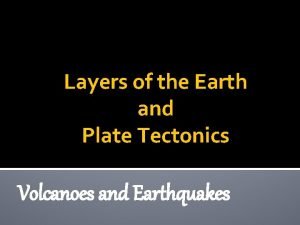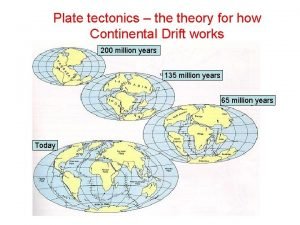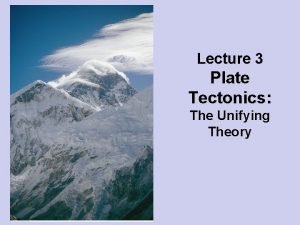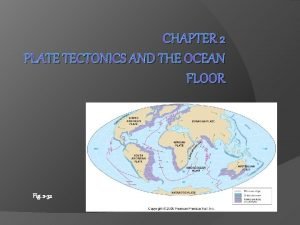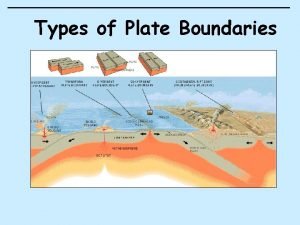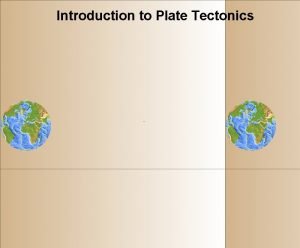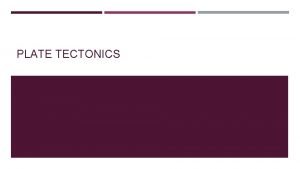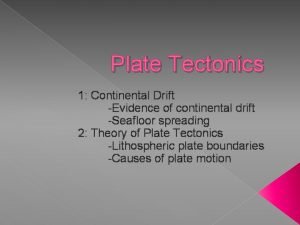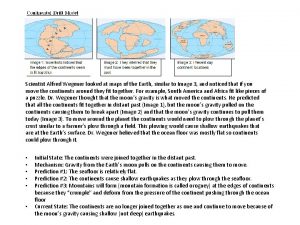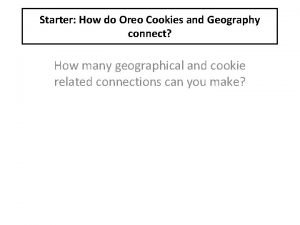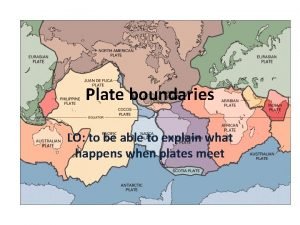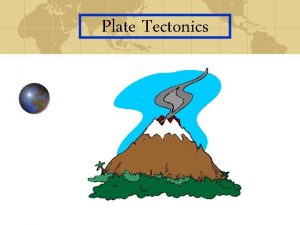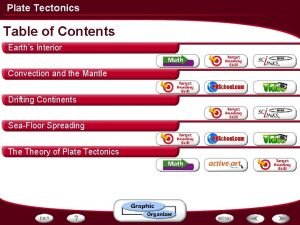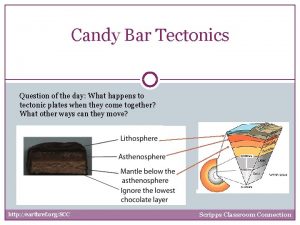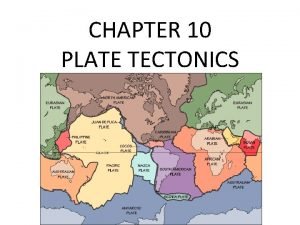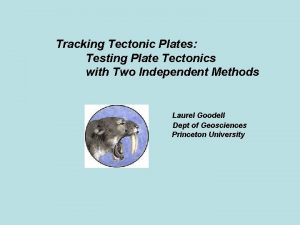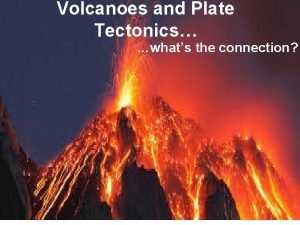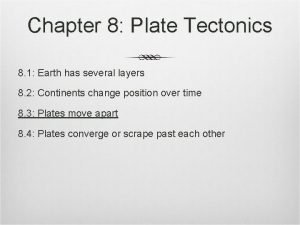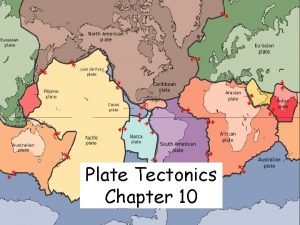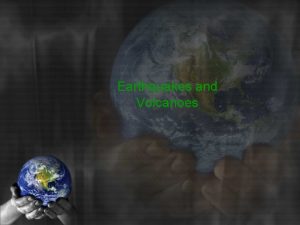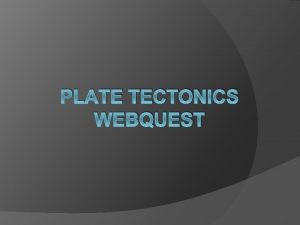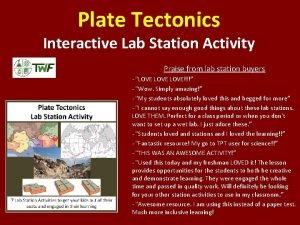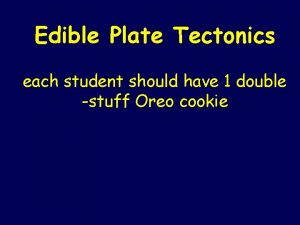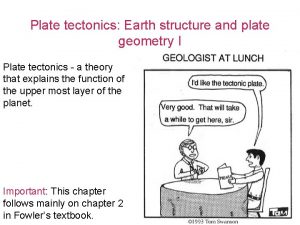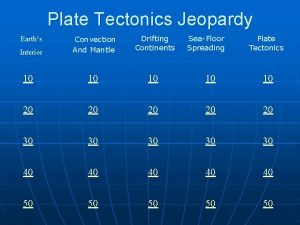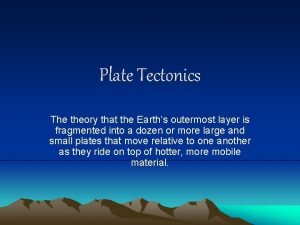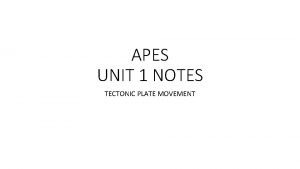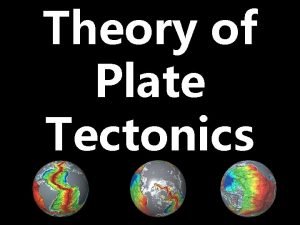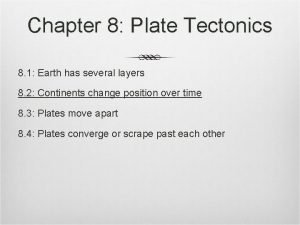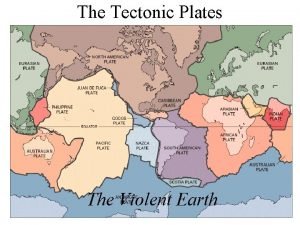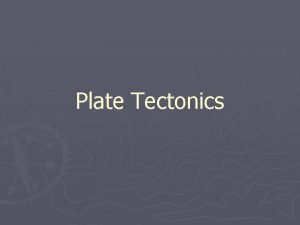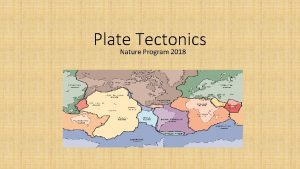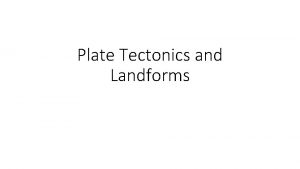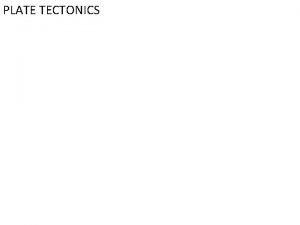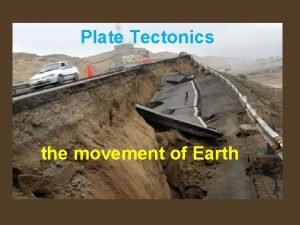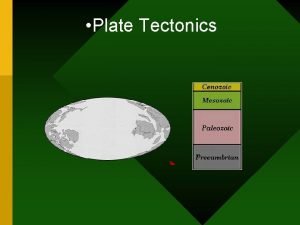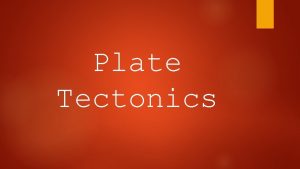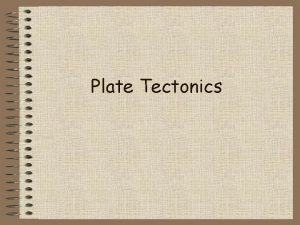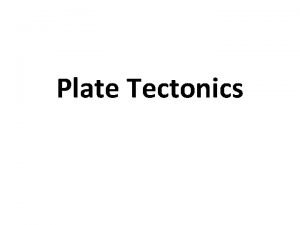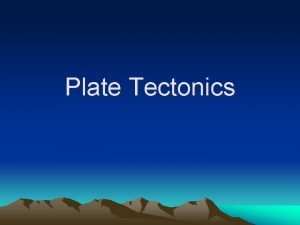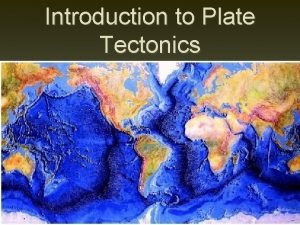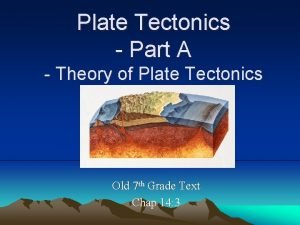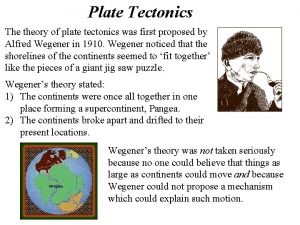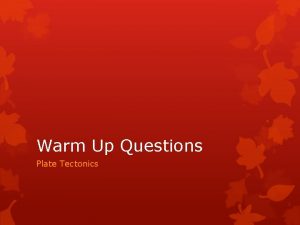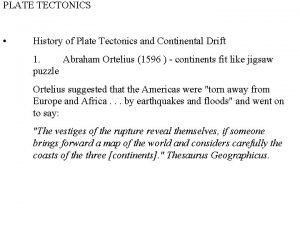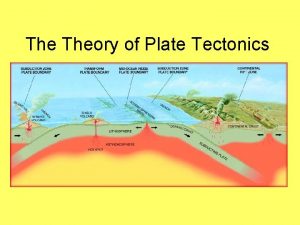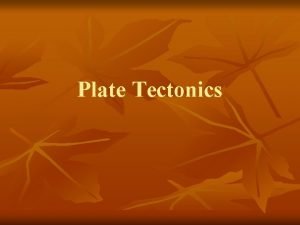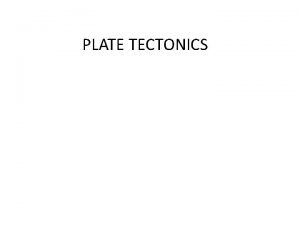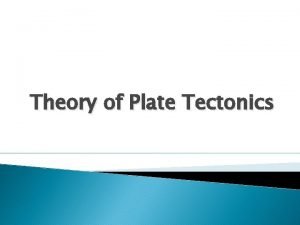Plate Tectonics What is Plate Tectonics The Earth


































- Slides: 34

• Plate Tectonics

What is Plate Tectonics • The Earth is broken into large Plates. • The size and position of Plates change. • Plate edges colliding - geologic activity • Cause of Earthquakes & Volcanoes • Creates Mountains • Deep ocean vents – site of creation of life

Earth has 3 Layers • Core • Mantle • Crust

Plate tectonics • Plates are driven by cooling of Earth (convection) • Gravity provides additional force to move plates. ? ? ? Modified from USGS Graphics Convection is like a boiling pot. Heated soup rises to the surface, spreads and begins to cool, and then sinks back to the bottom of the pot where it is reheated and rises again.

What are the tectonic plates? AKA: Lithospheric plate • The ~100 -km-thick surface of the Earth; • Contains crust and part of the upper mantle; • It is rigid and brittle; • Fractures to produce earthquakes.

Outer Layers of the Earth • The Lithosphere (Greek, Lithos for Stone) is the rigid, outermost layer of outer crust and uppermost mantle. This makes up the “Plate” of Plate Tectonics.

USGS Graphics What is the asthenosphere? Asthenosphere: • Is the hotter upper mantle below the lithospheric plate; • Can flow like silly putty; and • Is a viscoelastic solid, NOT liquid!!

Outer Layers of the Earth • The Lithosphere (Greek, Lithos for Stone) is the rigid, outermost layer of outer crust and uppermost mantle. This makes up the “Plate” of Plate Tectonics.

Three Basic Types of Plate Boundaries Divergent Using hands to show relative motion Transform Convergent USGS Graphics

Three Basic Types of Plate Boundaries Divergent Transform Convergent USGS Graphics

Tectonic Plates There a dozen large lithospheric plates (smaller plates not shown). Some plates have continents; some don’t. All are in motion. Question: What evidence is there for these plate boundaries?

Earthquakes There are thousands of small earthquakes every day “Strong” earthquakes (~M 7) occur once a month. >M 8 occur about once/year. Where are the deepest earthquakes? For earthquakes of the past 2 weeks, go to http: //www. iris. edu/seismon/

Earthquakes & Plate Boundaries Notice that the earthquakes coincide with plate boundaries, and the deepest quakes (blue) are in subduction zones. Question: Where would you expect to see volcanoes? Create your own maps at http: //www. iris. edu/quakes/maps. htm Modified from USGS Graphics

Volcanoes & Plate Boundaries This map shows that locations of volcanoes (ones above sea level) also tend to occur along the plate boundaries Modified from USGS Graphics

Tectonic Plates How fast are the plates moving? Plates move 1 -10 centimeters per year (≈ rate of fingernail growth). Fingernail growth plotted: http: //jclahr. com/science/earth_science/thumbnail/index. html Modified from USGS Graphics

Continental Drift • Continental Drift theory was proposed by Alfred Wegener in 1912. He used continental fit, distribution of fossils, ancient climates, and the wandering of Earth's polar regions to support his Theory. He stated the present continents were part of a super continent – Pangaea.

Continental Drift How fast are the plates moving? Plates move 1 -10 centimeters per year (≈ rate of fingernail growth). Source: http: //www. tectonics. caltech. edu/outreach/animations/index. html

Pangaea

Sea-Floor Spreading

Sea-Floor Spreading • Harry Hess proposed that new ocean floor is formed at the rift of mid-ocean ridges. The ocean floor, and the rock beneath it, are produced by magma that rises from deeper levels. Hess suggested that the ocean floor moved laterally away from the ridge and plunged into an oceanic trench along the continental margin.

Seafloor Spreading Source: http: //www. tectonics. caltech. edu/outreach/animations/index. html

Subduction • As new ocean floor is created by seafloor spreading at the mid-oceanic ridges it is consumed at the subduction zones where the lithosphere sinks under the asthenosphere.

Convergent Boundaries • Oceanic-Continental Convergence • Continent-Continent Convergence • Oceanic-Oceanic Convergence

Oceanic-Continental Convergence • When the leading edge of an oceanic crust collides with continental crust. • Oceanic crust is denser – it is subducted, or forced under the less dense continental crust. • A deep oceanic trench forms along a subduction zone.

Continent-Continent Convergence • When two leading edges of continental crust collide. • Neither crust is conducted – they have the same density. • Colliding edges are crumpled and uplifted, producing mountains.

Convergent Boundaries • Places where plates crash or crunch into each other. All the folding and bending makes rock in both plates break and slip, causing earthquakes. Rock deep in the Earth melts, builds up pressure causing volcanoes.

Continental Crush • An ocean floor will always slide under the land mass. This is because the land mass is more buoyant, or lighter, than the ocean floor. When two land masses meet neither will slide under the other. Instead, the two crush together at what is known as a collisional boundary. They crumple and fold. Some pieces of land are thrust over or under other pieces. The result is a mountain range.

Divergent Boundaries • Places where plates come apart are called divergent boundaries. When Earth's brittle surface layer is pulled apart, it breaks along parallel faults that tilt slightly outward from each other. As the plates separate along the boundary, the block between the faults cracks and drops down into the soft, plastic interior. The sinking of the block forms a central valley called a rift. Magma (liquid rock) seeps upward to fill the cracks. In this way, new crust is formed along the boundary.

Divergent Boundaries

Transform Boundaries Places where plates slide past each other are called transform boundaries. The most famous transform boundary in the world is the San Andreas fault. Los Angeles will not crack off and fall into the ocean as popularly thought, but it will simply creep towards San Francisco at about 6 centimeters per year. In 16 million years, the plates will have moved so much that Los Angeles will be north of San Francisco!

Transform Boundaries

• Summary Illustration

Collision of ‘Drifting’ India with Eurasia Side view of subduction, ‘drifting’ India, volcanoes, & mountain-building Source: http: //www. tectonics. caltech. edu/outreach/animations/index. html

Note on Source: First 8 slides are modified from a slide show prepared by Dr. Robert Butler, University of Portland, and Jenda Johnson, …the full source of which can be found at: http: //www. iris. edu/hq/programs/education_and_outreach/videos#B
 Layers of the earth lyrics
Layers of the earth lyrics Continental drift
Continental drift Unifying theory of plate tectonics
Unifying theory of plate tectonics From now
From now What are four types of plate boundaries?
What are four types of plate boundaries? Theory of plate tectonics
Theory of plate tectonics What is this process called
What is this process called Plate tectonics
Plate tectonics Compare continental drift and plate tectonics
Compare continental drift and plate tectonics Oreo objectives
Oreo objectives Collision plate margin diagram
Collision plate margin diagram Juan de fuca plate
Juan de fuca plate Lithosphere definition
Lithosphere definition Seafloor spreading material at trenches
Seafloor spreading material at trenches Candy bar plate tectonics
Candy bar plate tectonics Chapter 10 plate tectonics
Chapter 10 plate tectonics Plate motion calculator
Plate motion calculator Strombolian eruption
Strombolian eruption Chapter 8 plate tectonics
Chapter 8 plate tectonics Summarize the theory of plate tectonics
Summarize the theory of plate tectonics Plate tectonics
Plate tectonics Plate tectonics webquest answer
Plate tectonics webquest answer Plate tectonics interactive lab
Plate tectonics interactive lab Convergent boundary oreo
Convergent boundary oreo Earth rotation
Earth rotation Plate tectonics game board
Plate tectonics game board Plate tectonics definition
Plate tectonics definition Plate tectonics
Plate tectonics Plate boundaries apes
Plate boundaries apes The plate tectonics theory states that:
The plate tectonics theory states that: Continental drift vs plate tectonics theory
Continental drift vs plate tectonics theory Layers of the earth jeopardy
Layers of the earth jeopardy Chapter 8 plate tectonics
Chapter 8 plate tectonics Harry hess and seafloor spreading
Harry hess and seafloor spreading San andreas fault map
San andreas fault map
